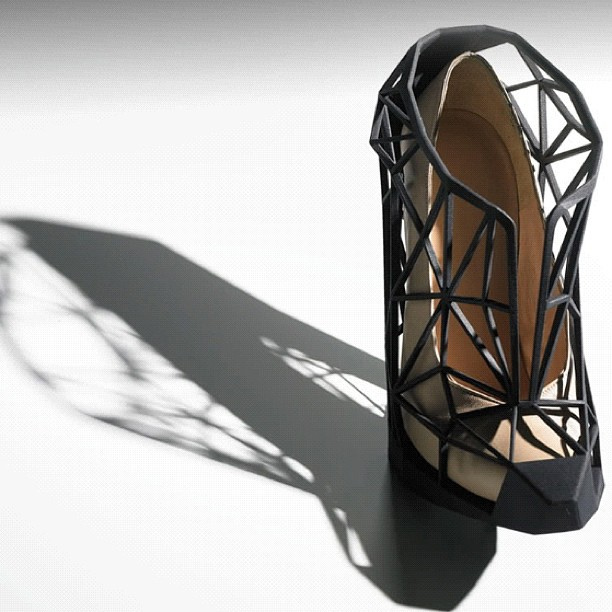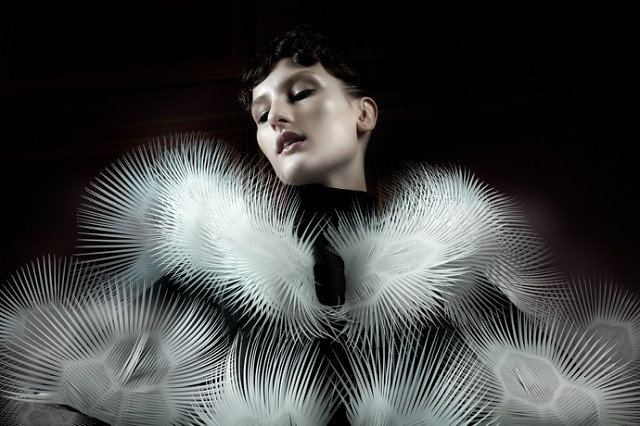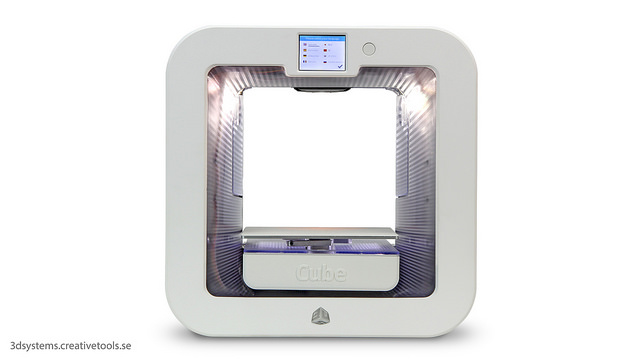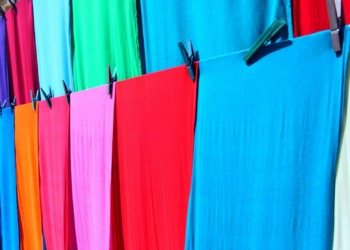In the 1980s, creating prototypes was time-consuming and expensive. That changed in 1986 when Chuck Hull unveiled the “SLA-1,” the first Rapid Prototyping System. While less known than Nikola Tesla, Steve Jobs, and Bill Gates, Hull changed the manufacturing industry and variations of his designs and technology would go on to revolutionize numerous industries from medicine to forensics. He provided a catalyst that led to printing tissue with blood cells, the possibility of creating strong replacement parts for cars and designing beautifully crafted chocolates. Fashion would soon be the next to be transformed.
During Amsterdam Fashion Week in 2010, viewers marveled at Iris van Herpen’s “Crystallization” collection. Fluid dresses, unconstrained by physics, were donned by models. The powerful play of lines and curves demonstrated the different flows of water, from the splash of a drop to the tranquility of a flowing river. It was innovative, it was daring, and it was a first. Van Herpen blended high fashion and technology with the first 3D couture to be worn on the runaway. A collaboration between Van Herpen, architect Daniel Widrig, and the 3D Printing design company .MGX by Materialise made the design possible. Van Herpen’s continuous originality made her 3D printed escapism dress from her “Escapism” collection one of fifty best inventions of 2011, according to TIME Magazine.

In this Photo: Dress from Iris van Herper’s “Crystallization” collection”
Van Harpen was not alone in her search to beautify 3D printing. The N12 bikini designed by Contiuum, designer Mary Huang, showcased the first 3D printed, ready-to-wear article of clothing. Using the SLS 3D printing process, Nylon 12 was created to make a functional, waterproof bikini. Andreia Chaves created the “InvisibleShoe” collection that fused handmade, Italian leather with an external 3D printed supple nylon. Danit Peleg created an entire 3D printed collection using home printers. Rigid designs bounce in her five-piece collection that began as a graduation assignment and became a basis for Peleg’s TED talk in 2015. With designer Ron Arad, pq created 3D eyewear with round and square frames. From hats to jewelry, 3D printing experimentation is being normalized and applauded for its freedom, newness and ingenuity. In this Photo: Andreia Chaves’ “InvisbleShoe” Photo Credit: Flickr/Romana Correale
In this Photo: Andreia Chaves’ “InvisbleShoe” Photo Credit: Flickr/Romana Correale
Big leaps are being taken as the technology improves. The modeclix project by the University of Hertfordshire took on the challenge of making 3D printed garments mirror the texture, comfort, and movements of traditional cloth. Feetz and United Nude commercialized the 3D printing process. With 3D Systems, United Nudes created a 3D printing retail experience where customer could gape at the creation of the “Float” shoe. The same could then be done at home with the downloadable design and 3D Systems’ Cube 3. Though restricted to invite-only, Feetz uses 3D printing and recycled material to create perfect fit, customizable shoes for men and women. Kipling and Materialise came together to showcase the flexibility of TPU 92A-1 with the 3D printed “City Jungle Shopper” bag that showed an interconnected Kipling monkey mascot design that gave a pinwheel effect in the pattern.
 In the Photo: 3D Systems Cube 3 Photo Credit: Flickr/ Creative Tools
In the Photo: 3D Systems Cube 3 Photo Credit: Flickr/ Creative Tools
And the future is only brighter. Using body modelling technology, Nervous System’s 3D Printed Kinematics Dress can be printed in 3D and worn with no assembly required. MIT industrial designers Christophe Guberan and Carlo Clopath and computer scientist Skylar Tibbits created 3D printed reactive shoes. Instituto de Biomecánica has developed an app to 3D scan the human body in just two pictures, which can provide better virtual try-ons and customizable clothing. Shifting through a clothes rack and clinching at the retched scrape of metal hangers gliding across a metal rack could soon be the past as 3D printer become cheaper and more user-friendly. While still in its infancy in fashion, one can still imagine the future of customization and advancements that could be made possible with 3D printing.
For a full mindmap behind this article with articles, videos, and documents see #3DFashion
—



 In the Photo: 3D Systems Cube 3 Photo Credit: Flickr/ Creative Tools
In the Photo: 3D Systems Cube 3 Photo Credit: Flickr/ Creative Tools





